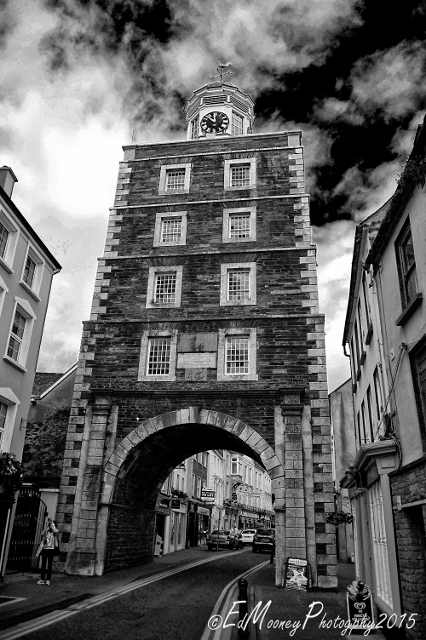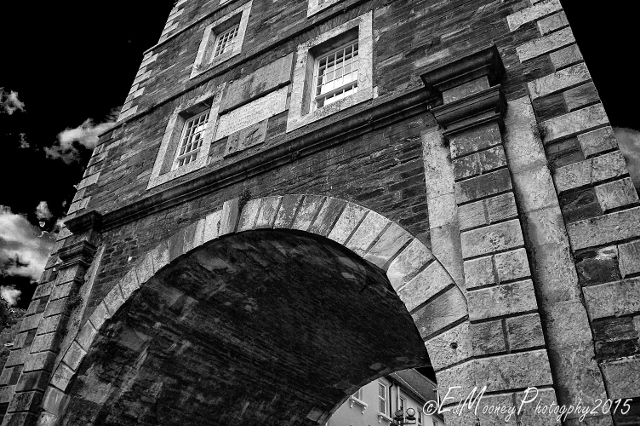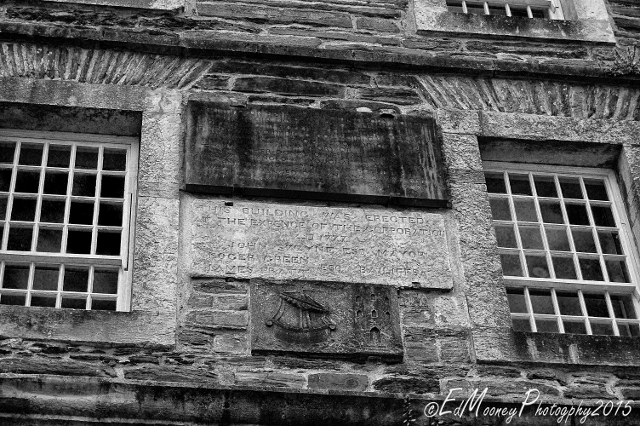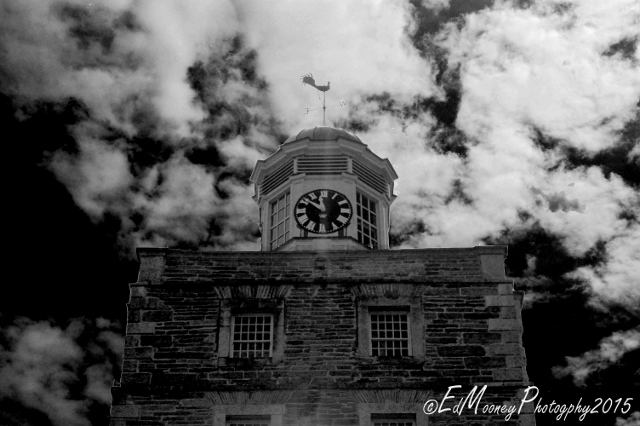One of the most distinctive features of Youghal is the unusual Clock Gate which can be found on the Main Street. Once one of the most important trading centres in Medieval Ireland, Youghal served many important trade routes to both northern and western Europe. Like many such towns of the time, it need to be a safe place for both residents and the merchants whom traded here. It was a town which was protected by a heavily guarded wall with numerous defensive towers and gates. Over time, the town required expansion, and another wall was built outside the town into which it could expand. By the mid-16th Century the Corporation decided to lease out the castle for private use. In 1563 the merchant Melchior Bluet leased the building. One of the gates which connected the old and new parts of the town, was the massive South Gate, which consisted of a pair of circular towers connected with a portcullis. Not only did this serve as an access point between the two parts of the town, but it is also said to have served as a prison. It was soon renamed the Trinity Gate/Castle, as a new South Gate had been constructed on the outer wall.
Trinity Gate once had a sundial in place, but in 1620 the Town Corporation decided that they wanted a clock installed on the tower. In order to finance the project, freedom of the town was given to merchants and other wealthy persons whom made financial contributions towards the work, which resulted in the final cost to the Town being the tidy sum of £113. In 1622 a man called Balthazar Portingale was appointed as the clock-keeper and was given free quarters in return for ringing the clock at certain times throughout the day. Despite numerous repairs over the years that followed, by Oct 1776 a decision was made to demolish the structure and to replace it with a gaol, along with clock and bell. The Gaolers lodgings consisted of two rooms over the arch, with another two rooms above to serve as the prison. With a bell room above that and a Spire to top it all off. A William Dyke is reported to have been paid £12 to demolish the old building and work began on the construction of the new tower, with workers being paid 2 shillings and 8 pence per day.
By May 1777 an engraver was employed to prepare two marble stones for the Clock Castle, with the Corporation arms and the magistrates names engraved on them. With the ever increasing number of rebels being arrested, in 1795 a new storey was added to the tower to make space for the number of prisoners being held. A number of United Irishmen were in fact publicly hung from the towers windows. As a symbol of terror and tyranny, I quite surprised that the native Irish did not burn this building to the ground. It continued to be used up until 1837, when it ceased to be used as a gaol and gallows. It then became a family home until 1959 when the last family left. The Clock Gate has not been in public use since housing a museum in the 1970s. What I found most interesting was the fact that you can still drive your car through the arch. If you do happen to be in the area, I would highly recommend that you see this building for yourself.
For these and more of my images, why not visit my Website or join me on Facebook or Twitter.









It looks so great! I really like medieval towns! 🙂
LikeLiked by 1 person
Thank you, the town is fairly modernised, but if you look closely you can still find tracess back to its past 🙂
LikeLiked by 1 person
I can imagine…
anyway, the clock gate is really cool! 🙂
LikeLiked by 1 person
Great pictures as always Ed. You really captured the mood of the buildings history with the knowledge of the hangings being intrinsic to the image.
LikeLiked by 1 person
An thanks Cameron, it always amazes me, what you can find when you do a little historical digging 🙂
LikeLike
Very true.
LikeLiked by 1 person
You must be getting tired of being called great… it happens all the time. So I am inventing a word that means “so great it can not be measured”… fluurvnark!
Your pictures are fluurnark!
901,403,866, 213 stars out of 5….
LikeLiked by 1 person
LMAO, thats brilliant, looks like an old Norse word? I reckon it will catch on quickly and soon be added to the Oxford Dictionary 🙂 Fluurnark 🙂
LikeLiked by 1 person
Fluurvnark, sorry, I forgot to add the ‘v’ in the last one. Fluurvnark… the only word that accurately describes your work! 🙂
LikeLiked by 1 person
And its already gaining popularity 🙂
LikeLike
Great photos Ed, and a very informative post about the Clock Gate 🙂
LikeLiked by 1 person
Thank you Andy, glad you enjoyed it 🙂
LikeLiked by 1 person
What a unique construction and interesting stories to go with it. It is indeed Fluurvnark. I love new words!!
LikeLiked by 1 person
LOL, Thanks Darlene, its definetly one for the dictionary 🙂
LikeLike
I wonder why no one else lives there now? Ghosts? 🙂 Thanks for the history.
LikeLiked by 1 person
I think it is used as a museum and tourist office from time to time, plus I dont think it would be a great place to live these days with all the cars driving underneath your kitchen 🙂
LikeLike
A very, very striking building. Just let’s hope they always err on the side of caution when it comes to letting those jumbo sized EC lorries come through!
LikeLiked by 1 person
LOL, dont think they would fit 🙂
LikeLike
You did a fabulous job capturing the medieval mood in your photos and thanks for the historic background.
LikeLiked by 1 person
My pleasure, glad you enjoyed them 🙂
LikeLike
That’s a beautifully preserved gate (and clock) and your moody photos do it justice in its historical context too. Well done, Ed.
Best wishes, Pete.
LikeLiked by 1 person
Much appreciated Pete, One of the last sets from Cork this year, its such a gorgeous place 🙂
LikeLike
I love reading the history of my ancestors. Thank-you for sharing.
LikeLiked by 1 person
Always a pleasure 🙂
LikeLike
Very interesting!
LikeLiked by 1 person
Thank you Tania 🙂
LikeLike
I love Youghal and although I’ve walked under that arch many times, I didn’t know much about its history, so many thanks for the heads-up on that! (and the beautiful pictures, as ever!)
LikeLike
Cheers mate, like so many places you just dont know what interesting stuff can be found until you go exploring. Your so right, Youghal is a great spot 🙂
LikeLiked by 1 person
A very attractive town is Youghal. Great photos and write up!
LikeLiked by 1 person
wonderful image of the clock tower gate!! Love your histories!
LikeLiked by 1 person
Thanks Cybele, I was about to pass it by, but my curiosity and the fact that you could drive underneath it got the better of me. 🙂
LikeLiked by 1 person
good thing!!
LikeLike
That first shot – love the composition. I can’t imagine having a family home in a building where people were hung from the windows in earlier times. Wow.
LikeLiked by 1 person